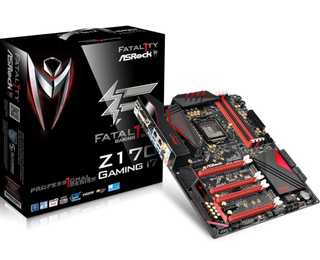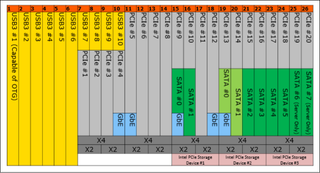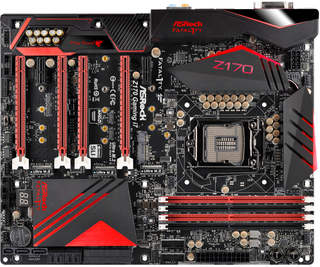Does ASRock's Fatal1ty Z170 Professional Gaming i7 Really Offer More Features?

ASRock announced a new addition to its high-end Fatal1ty product series, the ASRock Fatal1ty Z170 Professional Gaming i7, which is positioned as its highest-performance Z170 motherboard. But does it really offer more than ASRock's other Z170 boards?
At first glance, the ASRock Fatal1ty Z170 Professional Gaming i7 seems like an excellent motherboard jam-packed with the latest features, like SATA Express, M.2, USB 3.1, DDR4, and support for Skylake. Although ASRock's board unquestionably offers more connectivity than other Z170 ASRock boards, it is questionable to what extent users can take advantage of these features.
The HSIO Problem
Like all Z170 motherboards, the ASRock Fatal1ty Z170 Professional Gaming i7 features a total of 26 lanes from the chipset. On this motherboard, six are consumed by USB 3.0 ports directly from the chipset itself, while at least one (likely more) additional HSIO lane is used to connect a USB controller, which provides two additional USB 3.0 ports, as well as two USB 3.1 Type-A and Type-C ports.

The motherboard also supports a total of 10 SATA 3 ports alongside three SATA Express connectors. Similar to USB 3.0, these connections consume at least seven HSIO lanes. Six of the HSIO lanes are consumed and used directly as SATA 3, while the extra four SATA ports and SATA Express connectors will need at least one HSIO lane for a SATA controller.

Without considering anything else, that drops the free HSIO lanes down to six, and that is assuming that only a single controller each is used for USB and SATA, which itself would create a serious bottleneck for devices connected to those controllers.

Each HSIO lane is equivalent to a single PCI-E 3.0 lane, which is capable of roughly 8 Gbps of bandwidth (985 MB/s). Each SATA 3 port is capable of 6 Gbps (600 MB/s), and SATA Express requires 16 Gbps (1969 MB/s) of bandwidth to operate at full speed. Therefore, if ASRock is running all of these SATA devices off of a controller with more than a single HSIO lane, there will be a significant bottleneck.

Even if ASRock allocated more HSIO lanes to those controllers, there is still a connectivity issue. The motherboard also contains two gigabit Ethernet Intel NICs and two PCI-E x1 connectors, each requiring an HSIO lane, dropping us down to two remaining unused HSIO lanes.
Stay on the Cutting Edge
Join the experts who read Tom's Hardware for the inside track on enthusiast PC tech news — and have for over 25 years. We'll send breaking news and in-depth reviews of CPUs, GPUs, AI, maker hardware and more straight to your inbox.
ASRock also placed three M.2 ports and an mSATA connection on the motherboard. The M.2 ports are capable of consuming four HSIO lanes each, driving us way beyond what the Z170 chipset is technically capable of.
How Is This Possible?
The only practical way that ASRock could have added all of these devices is to use HSIO lanes for multiple devices. This may sound like a good idea, but HSIO lanes are capable of feeding only one device per lane at a time. What this means is that although you have an abundance of connectivity options, you can't actually use all of them at the same time.

ASRock doesn't come out and say this, but it doesn't hide the information either, for those who examine the specs. All of the M.2 ports (each with a separate lane) share lanes with two SATA ports and a SATA Express connector, so using an M.2 device instantly disables at least three other connections.
| Using | Will Disable |
|---|---|
| M.2_1 | SATA3_0, SATA3_1 and SATA_EXP0 |
| M.2_2 | SATA3_2, SATA3_3 and SATA_EXP01 |
| M.2_3 | SATA3_4, SATA3_5 and SATA_EXPO2 |
Does It Matter?
Although many may not see this as a serious issue, as users would need to use numerous connectivity devices before this becomes a problem, the extravagant amount of connectivity this board professes to offer is one of the attractive things about it, and many users will likely buy it without realizing they can't use most of the storage connections at the same time. Because there is no reason to pay for extra features you aren't going to use, it would be prudent for users to examine ASRock's other high-end boards which are capable of the same performance but with fewer connectivity options and a lower price tag.
There is currently no word on pricing or availability.
______________________________________________________________________

Michael Justin Allen Sexton (or MJ) is a Contributing Writer for Tom's Hardware. As a tech enthusiast, MJ enjoys studying and writing about all areas of tech, but specializes in the study of chipsets and microprocessors. In his personal life, MJ spends most of his time gaming, practicing martial arts, studying history, and tinkering with electronics.
Follow Michael Justin Allen Sexton @EmperorSunLao. Follow us on Facebook, Google+, RSS, Twitter and YouTube.
-
MasterMace There's no point in these expensive mainstream boards. They don't have enough lanes to support SLI to its fullest, and thus only are good for 1, maybe 2 gpus depending on how expensive they are (with the less expensive being more favored).Reply
For your enthusiast gpus, you're going 2011-3 for 40 lanes, or Xeon if you got money to spend for 64. -
Tom Griffin This is old news and Tom's Hardware addressed it in the Z170 chipset overview quite awhile ago. You will notice on each manufacturers specifications page that using x will disable y. I think the author needs to attempt to delve into reading previous articles before spouting the obvious.Reply -
db188 the point of Z170 is that it has optional connections, even if many of these are trade-offs. who the F cares about SATA Express anyways? it's DOA. tri and quad sli is a waste of money, even if sli didn't scale so horribly beyond 2 cards the cpu bottleneck would hold high end cards back. i think it's pretty obvious to anyone paying attention that Z170/Skylake is for gamers only. X99/Haswell-E is for gaming/workstation and if you're just going to render/model a Xeon setup is the way to go.Reply -
PureEnergi looked this chipset for quite a bit.. im running z97. The Cpu is only 17$ (i5) more than the 1150 Cpu where i shop; Plus if you buy the board ram processor together they give you a significant discount. The board isnt really that expensive either over an 1150. Setting aside the cost of jumping to a new ram platform (ddr4) there was very little reason to upgrade from a 1150. Seems most of the ASUS boards pimp the sata express which.. I see as a gimmick. I dont entertain many other brands. Gigabyte and MSI have caused me serious issues in the past. I think Ill wait till something more substantial comes out.Reply -
warezme I haven't worried about upgrading in a long time but let me get this straight. What this is showing is that the Z170 chipset isn't technically possible of supporting not even 8X PCIe lanes let alone 16X lanes without basically rendering the rest of the board bare of any other function? So what is the performance chipset with plenty of lanes?Reply -
firefoxx04 This has always been a thing. My manual for my z97 extreme 6 clearly states what ports are disabled when sata express or m.2 is utilized.Reply
It's the not the board manufacturers responsibility to make sure it's users understand the nitty giddy way the chipset works.
Good read, but saying asrock does not "come out and say this" and then saying "they don't hide it either" seems like a pointless statement unless the reason behind it was to make them look bad. -
Quixit Well, the shared SATA Express lanes don't matter. NO ONE has ever made a SATA Express SSD.I'm sure the M.2 sharing with SATA3 probably annoys people who love to have huge numbers of storage devices, but that's about it.Reply
Shared bandwidth on things like this is pretty normal, My P8-Z68-V PRO board from years ago has a PCI-E 4x slot that shares with the secondary SATA controller and USB controller. Annoying, but not new. -
IInuyasha74 ReplyI haven't worried about upgrading in a long time but let me get this straight. What this is showing is that the Z170 chipset isn't technically possible of supporting not even 8X PCIe lanes let alone 16X lanes without basically rendering the rest of the board bare of any other function? So what is the performance chipset with plenty of lanes?
Well the PCI-E x16 connections are powered by the CPU, so graphics cards shouldn't be an issue. I probably should have mentioned that in the article so as not to confuse people. The real issue is that you end up paying for a lot of connectivity that you just can't use. -
diagrafeas My ideal configuration would be:Reply
1st Slot: PCIE x16(x16)
2nd Slot: none (m.2 PCIE x4)
3rd Slot: PCIE x16(x8 electrical from CPU)
4rth Slot: none (m.2 PCIE x4)
5th Slot: PCIE x16(x4 electrical shared with 1st m.2)
6th Slot: PCIE x16(x4 electrical shared with 2nd m.2)
7th Slot: PCIE x16(x4 electrical)
Which leaves
6+4 USB3 (preferably 2 internal)
4 USB2 (preferably 2 internal)
2+(4) SATA3 (#)->shared
1 Gigabit LAN
x1 PCIE for wifi ac
2 SATA Express (shared with 2 m.2 which are shared with 2 PCIE x16(x4 electrical)) or (4) SATA Ports).
So you could use 2x 1m.2/or 1PCIEx4/or 1SATA Express/or 2 SATA at time.
Most Popular

